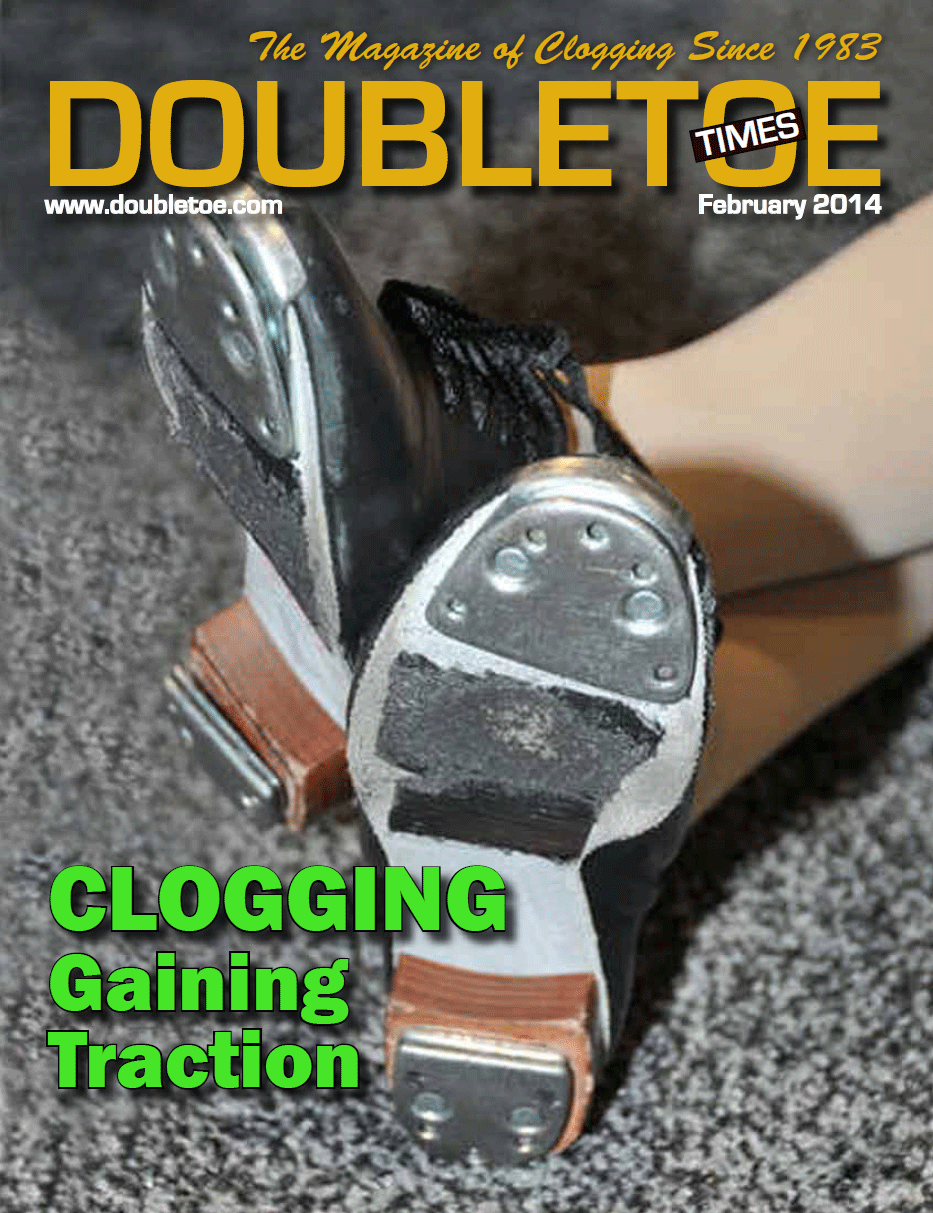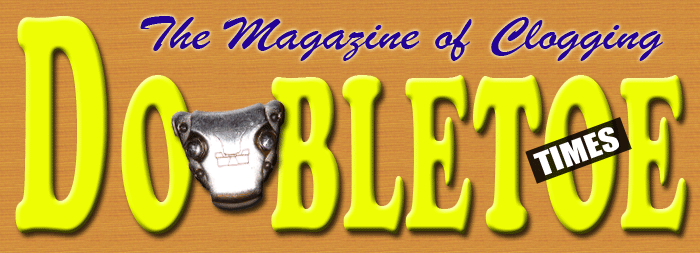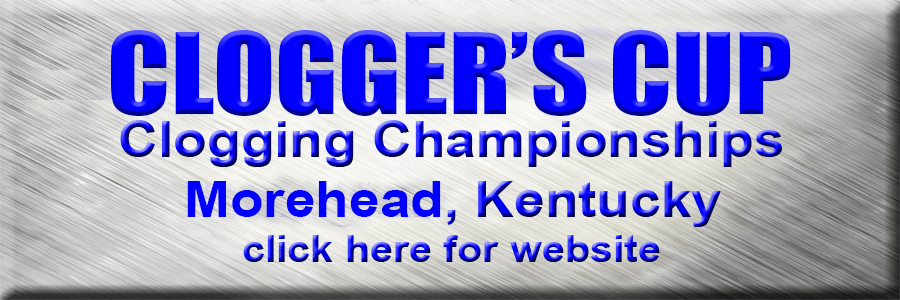 |
 |
|
DOUBLE TOE TIMES SPONSORED EVENTS DOUBLE TOE TIMES SECURE ONLINE STORE |
|
A Brief History of Clog Dancing Understanding Clogging Step Notation
A Brief History of Clog Dancing By Jeff Driggs
Appalachian and modern clogging owes its roots to a melting pot of dance traditions, including the Lancashire clog dance of England and its signature shoes. During the Industrial Revolution, the working classes of northern England flocked to work in coal mines, pits and cotton mills to make a living. Not the most likely place for the birth of a traditional pastime? Well actually, yes. It was among these cobbled streets that the English tradition of clog dancing was born. Although the clog dancing of northern England that we recognize today was started here, it was long before this that dancing in clogs began. It is thought that ‘clogging’ came to England as early as the 1400s. It was at this time that the original completely wooden clogs altered and became leather shoes with wooden soles. In the 1500s, they changed again, and separate wooden pieces were used to make the heel and toe. This early dancing was less complicated than the later ‘clog dancing’.
My personal perspective on some of the influences that I have observed and their impact on the style of clogging. It is more fun if you mentally picture me with my glasses pushed down on my nose, in my best overbite and Jerry Lewis voice. Please feel free to comment and add to the discussion. There are so many to celebrate. Having seen clogging most all of my life and getting involved in the activity in the late 1970's and early 1980's, I got a front row seat to many of the influences that changed the face of modern clogging. As someone who first learned by watching and sharing steps, I began with a "backstep" style, meaning the doubletoe comes from flapping the ball of the foot on the flat foot that has weight then drawing back the opposite ball of the foot to a step (flap, ball step). The style produced a pronounced drag slide. You will see me dancing this style in a video of the first National Clogging Convention when JoAnn Gibbs (with help from Tandy Barrett) is calling dancers to the center of the floor to rise and shine. The style goes well with the really fast live music that brought dancers to the floor in the halls where I first learned to clog in West Virginia. Teams like the Kentucky Chimes, Blue Ridge Mountain Dancers, Daniel Boone Cloggers and others danced this style and it it beautiful to watch and hear. The bent knees and up and down motion of the dancers is almost a lost art. Upon taking a structured class, joining a team and beginning to attend workshops, I learned the doubletoe step that is most common. When I joined a performing team early in my clogging, the directors said that their first mission was to break me of that "lazy doubletoe" back-stepping style. Throughout Tennessee and Western North Carolina, a style called "buck" was being shared by dancers like Jackie Christian, Pam Collins Watkins, Burton Edwards and others. Because competition often drives the changes in modern clogging style, Burton inspired a whole generation of dancers to pursue this heel toe patter-style with his staccato sound, fluid motion and grace. The patter added 2 more percussive sounds to the basic step, going from 5 (double toe step rock step) to 7 (double toe step heel ball heel step). Buck dancing was also the name given to the low to the floor dance style seen in middle Tennessee and being handed down by Robert Spicer, and in Western Carolina by Robert Dotson and others who learned it from black dancers and elders in their communities. In the mid 1980's a young troupe of Ottawa Valley step dancers led by Judy Waymouth attended the Possum Holler workshop in Fontana at the invitation of Tandy Barrett and showed a jaw-dropped audience the French Canadian step dance style that would forever change modern clogging. Like buck, the style took the weight from the flat of the foot to the ball of the foot, and the action comes from the bouncing time note of the ball of the foot with doubles, stamps and stomps to punctuate the rhythm. The clogging version of the "Canadian Basic" is a slight variation of the actual Ottawa Valley step and most likely came from those of us at the time who learned the step from Judy and in our zeal to teach it and incorporate it in our choreography made it more "cloggy." (haha) This style also added percussive sounds, with 7 distinct sounds (dou-ble step dou-ble hop touch). Raising the weight to the ball of the foot, with the light bounce of the style made "double-doubles" the signature of the modern competition clogger and the gauge of one's power and percussiveness. In the 1990's a young competition dancer named Mark Clifford took pliers to his clogging shoes and removed the shank, a flat metal plate that helps to hold the shoe's arch, making it possible for him to point his toe straight down to the floor and put his weight on it (much like a ballet dancer uses the toe box of the shoe). Mark was not the first dancer to do a toe stand. Ballet and Yoga do it. Elvis did it. Michael Jackson did it. Mark incorporated this action into his choreography in such a way -- and to such success in competition -- that it influenced clogging vendors to carry "split sole" shoes so that dancers could master this advanced technique. The "toe stand" has become an integral part of modern clogging's advanced footwork. I have had this clogging style evolution discussion with many people through the years and these examples are purely from my personal experience and perspective, but these particular examples show how one person can influence an art form in dramatic ways. I've heard folks speculate about the origins of the drag-slide style of Appalachian clogging and how the melting pot that is America brought so many cultural dances together. I have also heard well educated historians throw away points of view because there is no concrete trail to validate it. Without this discussion, future generations of cloggers might do this same speculation on how clogging evolved in our time. Sharing history, documenting it and passing it down is so important. That's why this exercise is so fun to me. Of course, there are so many more people than those included here that in my clogging experience have made an impact on clogging, both at the recreational level and competition level. You can't talk about clogging history without recognizing the work of Bill Nichols, the grandfather of modern clogging style and terminology. Bascom Lamar Lunsford, Hubert Hayes, the Bannerman Family, Cecil Masters, Sam Queen and the Soco Gap Dancers, Ben Smathers, The Sloan Family and many others are legends in clogging history. Gloria Driver's sharing of clogging in the Western square dance world introduced many people to clogging. Shiela Popwell and others helped to spread the use of terminology in formats and booklets and JoAnn Gibbs created workshop teams that spread the line dance form in workshops all over. Bob Johnson of Virginia, The McLerrans of Indiana, Dennis Cobia of Utah, Ralph Case of Maryland, Richard Jett of Kentucky and others fostered generations of cloggers and mentored so many. Regions found clogging and "family trees" of clogging instruction were created through folks who brought clogging home with them and spread it. Folks like Violet Marsh, Lucy Johnson, Big John Walters, Marge Callahan, Gina Zaragoza, and scores of others made impacts in their areas when they promoted clogging. In competition, dancers like Burton Edwards, Pamela Watkins, Brent Montgomery, Sonja Shepard, Sherry Glass Cox, Mark Clifford, Brandon Norris, and so many others set the bar, and teams like Starlite, The Flatland Cloggers, Master City, Pride N Joy, Leather N Lace, Steele Family, Clogging Express, Clogging Sensation, Power and Precision, Dynamic Edition, Final Destination and others paved the way for today's Tap This!, All That!, STOLE POWER and more. I encourage cloggers to join in the discussion, to lend your histories and stories and for all of us to learn more about each other and this dance we love so much. Understanding Terminology and Step Notation(reprinted from Clogmopolitan Volume I, No. 5)
The National Clogging and Hoe-down Council adopted the "Eight Basic Movements" of clogging on May 13, 1978 as a means of standardizing teaching methods, cueing and step notation. These standards were soon adopted as well by the Clogging Leaders of Georgia (now known as C.L.O.G., Inc.) and throughout the years much has been done to further standardize the way in which clogging teachers teach, cue and abbreviate step descriptions. Sheila Popwell, the former editor of the Flop-Eared Mule and a renowned clogging innovator, did much do popularise the Basic Steps and Terminology which is still widely accepted today. Through a column known as "Clogmunication", Kevin Sellew of Alabama also has done much to help provide a forum through which standardization could be discussed and developed.
For the sake of understanding, "Clogmunication " divided the understanding of movements between "Traditional Clogging" movements and "Contemporary Clogging" movements. Later, Buck Dance Terms were added to further describe movements.
TRADITIONAL CLOGGING TERMINOLOGYAll traditional clogging steps are made up of some combination of the following basic movements. The movements themselves fall into two groups -Toe Movements and Heel Movements. Each Toe Movement occurs on an upbeat of the music and is followed by a Heel Movement which occurs on the downbeat of the music. There are no silent or syncopated beats in Traditional Clogging. The rhythm of the dance is kept by the heel. Anytime the heel is sounded, the knee is flexed and then straightened on the following upbeat, resulting in the characteristic up and down motion of the dancer's body. The word "click" is used in the descriptions below to indicate that a tap has contacted the floor. All clicks should have a sharp, clear sound, not scuffed or muffled.
HEEL MOVEMENTS These fall on the downbeat (or bass beat) of the music
HEEL The weight of the body is already on the ball of the foot when the HEEL movement is done. Snap the heel down, producing a sharp click, and flex the knee downward, distributing the body weight along the entire length of the foot.
STEP Place the entire foot flat on the floor, producing a click with the toe tap and the heel tap at the same time and transferring the body weight along the full length of the foot while flexing the knee downward.
SLIDE A down and forward counterpart of the up and back motion of the DRAG (see TOE MOVEMENTS). With the foot flat on the floor and the knee straight, roll your weight up onto the ball of the foot, letting your knee begin to go slack. As the weight of your body begins to drop forward and down, let the instinctive tightening of your thigh muscles save you from a fall by sliding your foot forward (bout the length of your foot) and then letting your heel snap down, producing the click and redistributing your weight along the whole length of your foot. At the end of the SLIDE the knee will be in a flexed position. (Also can be done with both feet on the floor in the same manner.)
TOE MOVEMENTS These fall on the upbeat of the music
TOE The ball of the foot produces a click while the heel remains out of contact with the floor. TOE implies that the body weight has been transferred to the ball of the foot. The knee should be basically straight.
DOUBLE TOETwo clicks are produced in the space of on upbeat of music. The ball of the foot strikes the floor during the forward motion of a short kick and the knee straightens (ankle is relaxed and foot angles downward). The knee bends upward immediately and the same foot swings backward with the ball of the foot striking the floor again in the same spot. The heel should not touch the floor. The two motions of the foot are considered to be one movement with no hesitation between them. Normally, the clicks occur slightly in front of the body, but they may be done in other directions as well.
ROCK A click is produced by transferring the weight onto the ball of the foot slightly behind the body's center of gravity. The knee is in a flexed position at first, causing the body's weight to "rock" back slightly as the center of gravity changes. The opposite foot is always lifted off the floor during a ROCK. The heel of the foot doing the ROCK does not touch the floor, but the knee does straighten.
BRUSH The foot is allowed to swing from the knee with a pendulum action. The ball of the foot produces a click by striking the floor and continuing in the direction of the swing (which may be to the front, to the rear, or crossing in front or in back of the opposite leg). Movement comes from the hip and the knee joint, and the knee of the BRUSHing foot always bends upward following the click (at the same time as the following heel movement).
DRAG The foot is flat on the floor and the knee is flexed when the DRAG begins. With a springing motion which moves the weight of the body up and back, straighten the knee allowing momentum to lift you heel slightly off the floor and drag your foot back about half the length of the foot. The weight is distributed along the length of the foot at the end of the movement and there is no distinctive click. (This can also be done with both feet on the floor in the same manner )
NOTE: Much of what is considered to be "traditional" clog dance styling depends on the part of Appalachia the definitions come from, but the following points are frequently raised: Smooth flowing motions with a constant DRAG-SLIDE incorporated into the footwork- no head bobbing, no arm waving, no jumpy or jerky body actions. Feet no more than 6 to 8 inches off the floor- no one but the floor should see the bottom of your clog shoes. No silent or syncopated beats -toe movements are executed on upbeats and heel movements on downbeats.
CONTEMPORARY CLOGGING TERMINOLOGY
Since clogging is a living folk dance, part of what the dance is will be defined by what folks are dancing at any given time. Accordingly, new movements and new ways of using traditional movements are constantly being developed. As well, liberties are being taken with the "rule" of toe movements on upbeats and heel movements on downbeats. At the same time, however, try to remain aware that there is a distinction between what is traditional and what is contemporary so that you can keep your students informed (as well as happy!).
With the above points in mind, the following are the Contemporary Clogging Movements you'll se around the clogging floor these days:
HOPAn extension of SLIDE used in describing any upward motion that causes both feet to lose contact with the floor. The hop occurs with the upward motion taking place on the upbeat of the music and the click produced on the bass beat when the foot comes back into contact with the floor. The knee is flexed downward as you land. Landing after the hop may take place on the same foot that did the push off into the air, or the HOP may be used to change the weight to the opposite foot depending on the demands of the step being done. A foot designator L or R beneath the word HOP on a cuesheet would indicate the foot change.
SLURFeet will be slightly apart when a SLUR begins. On the upbeat, draw the toe tap along the floor (giving a slurred tap sound) toward the weight-bearing foot (usually ending across in back). Drop the heel to the floor producing a click on the bass beat. Originally SLUR was separated from the following beat, but today most choreographers assume that you will automatically include the heel sound when using the term SLUR.
CLICKDescribes a motion where the sides of your clogging shoes are touches together. As with slur, most choreographers assume that you will click your heels together on an upbeat and then sound a heel tap on the following bass beat. Several varieties of CLICK exist today and are further defined by the styling terms provided with the step.
KICKA variation of the BRUSH that simply omits the sound of the toe tap by eliminating any contact with the floor. Leg motion and action is the same as the BRUSH.
STOMPA strongly accented flatfoot step taking the full weight of the foot.
TOUCHA term used to imply the same sound and motion as that of a TOE, but the foot ins immediately picked up again without transferring the body weight to that foot.
STAMPA flatfooted TOUCH
BREAKThe entire side of the foot has been turned sideways and away from the other foot to become flush with the floor. Weight is borne by the other foot.
PIVOTDescribes a motion on the ball of the foot in a given direction. Usually occurs on the upbeat and does not necessarily include dropping the heel on the following bass beat. Therefore, the next intended movement should be written out as well.
PULLIndicated that the dancer will "scrape" the tip of the clogging shoe along the floor usually toward the other foot. Can be done from the rear, from across in back, from across in front, etc.
BUCK DANCE TERMINOLOGYBuck Dancing has come to be recognized in clogging circles as a specific style of dancing that differs from flat-footing in that a buck dancer keeps his weight on the balls of the feet and produces clicks by the interchanging of heel and toe movements to make what has been described as a "patter" sound. In the mountains of West Virginia, where I come from, the term "buck dancing" is used to describe any solo freestyle dancing -whether it be traditional clogging, flat-foot or otherwise. By the same token, dancing with a partner is known as a "buck and wing" dance. .
The terms outlined below are used to described movements used in the heel -toe dance style commonly known as "buck dancing":
BALLThe transfer of the body weight in a stepping motion to the ball of the foot with the knee bent slightly.
BOUNCEThe same as BALL, but with a hopping motion instead of a stepping motion. You may BOUNCE on the same foot or use it to change from one foot to another .
DIGA step (transfer of body weight) onto the hack edge of the heel.
FLANGEA term used to indicate that the dancer has completely turned the foot over and outward to bring the area of the shoe which covers the last two toes flush with the floor. The heel is aimed upward and weight is borne by the other foot
FLICKA short back BRUSH of the toe tap (usually following a heel sound from the same foot)
HITA touch of the back edge of the heel tap to the floor without any transfer of weight to the floor
POINTA touch of the tip of the shoe (NOT the ball of the foot) to the floor behind the body (or across in front or in back of the opposite foot, etc.)
SKUFFA short forward brush with the heel tap striking the floor. Normally, the front portion of the heel tap is the area which produces the click.
SKUFFLEA short forward and back brush which produces two sounds from the heel tap in one beat of music (&a).
SLIPA forward chug on the ball of the foot only -no heel tap sound is produced.
SNAPFrom a foot flat on the floor (normally done as a part of the DRAG on the same foot), the toe of the foot is raised slightly and then immediately dropped again to produce a sound of the toe tap.
ABBREVIATIONS USED IN STEP NOTATION
Listed below are the most commonly agreed upon abbreviations used in the notation of steps on cue sheets. In the early 1980's a movement was afoot to used one letter abbreviations for the eight basic movements used in traditional clogging. Some have been accepted, but most of the movements are more commonly recalled using two letter abbreviations. I have listed the abbreviation most commonly used for each movement.
Traditional Clogging Movements(most commonly used abbreviations) Term Most Commonly used 1 letter or other Abbrev. Brush BR (B) Double Toe DT (D) Drag DR (G) Heel H Rock R Slide SL (E) Step S Toe T
Contemporary Clogging Movements(most commonly used abbreviations) Term Most Commonly used 1 letter or other Abbrev. Break BRK Click CLK Hop HOP Kick K KIK Pivot PVT Pull PULL PUL Slur SLUR SLR Stamp STA Stomp STO Touch TCH
Buck Dance Movements(most commonly used abbreviations) Term Most Commonly used 1 letter or other Abbrev. Ball B (BA) Bounce BO Dig DIG (DG) Flange FL Flick FLK (FC) Hit HIT (HT) Point PT Skuff SK Skuffle SF Slip SLP (SP) Snap SNP (SP)
Directional Designators (written in parentheses following the movement in a horizontal format and to the outside of the movement in a vertical cue sheet format)
b back f front o out s side x uncross (usually follows xif or xib)
bs beside ib in back if in front in toward the weight bearing leg up raising of the foot
xib across in back xif across in front out away from the weight bearing leg ins inside (beside the instep of the weight bearing foot) ots out to the side o&b out and back (as a BRUSH starting from an xif position) oba out, back and around (foot makes a horizontal semi-circle from front to back) xba across, back and around (foot makes a vertical circle behind the body)
Foot Designators (written beneath basic movements) L for Left foot R for Right foot
Separation Designators(written between basic movements)
On a CLOG Standard Cue Sheet: / indicates that the movements on each side of the "I" are done simultaneously S / H(F) L R
On a Lined Score sheet (Developed by Bill Nichols, Adapted by Jeff Driggs, Simone Nichols) Movements appearing in line with each other above and below the step line are done simultaneously L S__ R H(F)
Timing Designators(written beneath the foot designators)
e marks a 1/4 count & marks an upbeat (1/2 count) a marks a 3/4 count 1 - 8 numbers a bass beat (full count)
|




